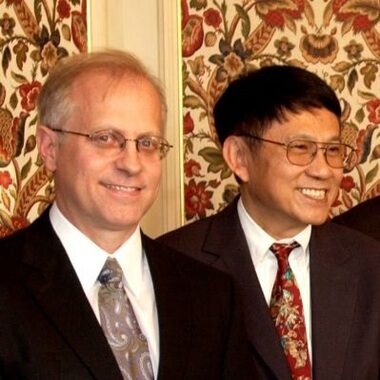Interview mit Russell Hemley 01.12.2009 (englisch)
USA - USA/China
Russell Hemley und Ho-kwang Mao
Balzan Preis 2005 für Mineralphysik
Für ihre bahnbrechenden gemeinsamen Arbeiten über das Verhalten von Mineralien unter extremen physikalischen Bedingungen. Als produktives Team haben Russell Hemley und Ho-kwang Mao mit ihren Arbeiten bedeutungsvolle wissenschaftliche Beiträge auf höchstem Niveau geleistet. Sie haben Methoden entwickelt, welche die Untersuchung des Verhaltens verschiedenster Stoffe – wie Wasserstoff, des am weitesten verbreiteten “Minerals” des Universums – unter extremen Bedingungen von Druck und Temperatur erlauben. Die Ergebnisse der Arbeiten von Russell Hemley und Ho-kwang Mao sind für unser Verständnis der Natur und unserer Erde von grundlegender Bedeutung.
Interview mit Russell Hemley
www.balzan.org 1. Dezember 2009
Russell J. Hemley, Balzan Prizewinner 2005, Director of the Geophysical Laboratory at the Carnegie Institution in Washington, was awarded the prestigious 2009 Bridgman Award, which is named for Percy Williams Bridgman, who won the Noble Prize in Physics in 1946 for his discoveries and for his invention of many research techniques in high-pressure physics. Russell Hemley and his Carnegie colleague Ho-Kwang Mao are jointly winners of the 2005 Balzan Prize for their work in Mineral Physics. Professor Mao is also a past winner of the Bridgman Award.
It has been an exciting year for the Geophysical Laboratory at Carnegie Institution, which was also recently chosen to be one of 46 Energy Frontier Research Centers (EFRCs) by the US Department of Energy to investigate solutions to the energy crisis. Professor Mao will be the Director, and Professor Hemley will be the Associate Director of a new center called EFree, which will manage this project. The Geophysical Laboratory was also the recipient of a $4 million grant from the Alfred P. Sloan Foundation earlier this summer. The grant will be used towards the study of carbon in the Earth’s deep interior. A center called the Deep Carbon Observatory will be created at the Geophysical Laboratory. This will be an international project, involving scientists from more than 20 countries, and will likely last for a decade.
In our third interview in a series about Prizewinners in the United States, after Alan J. Heeger and Bruce Beutler, Balzan spoke with Professor Hemley to follow up on the progress of his Balzan project and to learn more about the recent developments at the lab.
Professor Hemley began our discussion by describing some of the events of the last year, including the Sloan Foundation grant. «We are tasked to study Carbon in the earth’s core in its broadest sense. We need to study it at the crust level and how that impacts the surface carbon. It’s quite unusual to focus on one specific element like carbon. We actually know surprisingly little about Carbon. There can be fundamental implications from learning more about carbon in the earth’s core».
One well known material made from Carbon is Diamonds. Hemley has already made diamonds under high atmospheric pressure: «This is a spectacular material which can transmit heat fast and can be used in many future applications such as lasers, computers, electronic devices, optics and cutting materials. Oddly enough, the larger diamonds, such as the Hope Diamond are particularly flawed. We want to create a Hope Diamond without those defects».
Hemley and his colleagues at the Geophysical Laboratory have their work cut out for them with their new status as an EFRC and the newly initiated Carbon Observatory: «This is truly an exciting time for us. The real challenge will be to use these grants strategically to really make a difference in energy. One of the fundamental problems we always had was discovering the nature of the Earth’s carbon. In order to do this kind of work, you really need an interdisciplinary approach and special training in how materials work under extreme conditions».
Hemley’s work is considered to have potentially crucial implications in a wide variety of fields and for many applications. «We need to better understand the biological limits of life on planets outside of our solar system. This takes knowledge of basic principles of physics, chemistry. We need to understand how forms of life react under extreme conditions and how they can survive in crude environments at a molecular level. In order to study these types of issues, scientists need to have very wide array of knowledge in different fields. Currently, departments are generally more specialized as opposed to having a broad multidisciplinary approach».
Instead of complaining about the lack of such a program, Hemley and Mao used their Balzan Prize money to fund just such an interdisciplinary program for young scientists. The Hemley and Mao program supports scientific research in high school, college and graduate schools. «Students can apply to be summer scholars with a stipend from the Balzan Prize award. The program is considered to be an outstanding success and has attracted many participants over the past few years». Graduate students like the work precisely because of this innovative, multidisciplinary approach, according to Hemley.
This is not typically done and is very cutting edge. «It can be a challenge to find students with knowledge of both physics and biology or technology and geology but that’s what we’re working towards. The students are very excited and so are we».
Susannah Gold
New York
